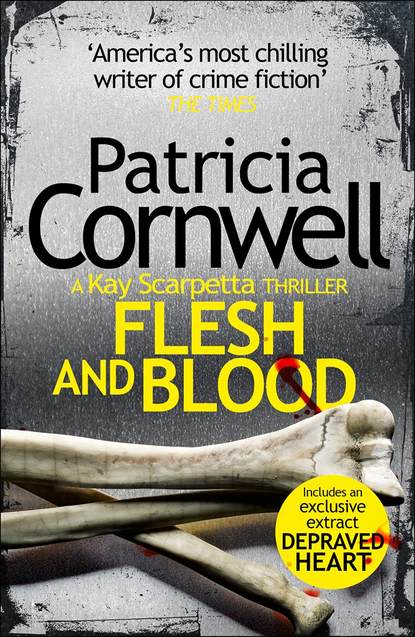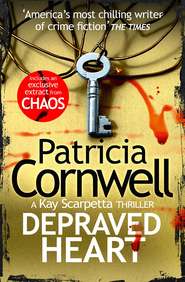По всем вопросам обращайтесь на: info@litportal.ru
(©) 2003-2024.
✖
Flesh and Blood
Автор
Год написания книги
2019
Настройки чтения
Размер шрифта
Высота строк
Поля
“Did she hear gunshots or anything that might have been gunshots?” I pull on gloves.
“She says she didn’t, and there were no reports of shots fired in the area. We’re already questioning the neighbors. So far coming up zero. But the grad student?” He glances back at the woman, standing rather dazed on the sidewalk now. “Angelina Brown, twenty-four, getting her doctorate in education.”
Marino is jotting down the information, his mouth set as if he just ate something that didn’t agree with him.
“She did make one interesting comment,” Machado continues, “and for sure we’ll follow up on it. Apparently her desk is in front of the window facing the street and she has a bird’s-eye view of who’s out front or entering or leaving the house. She says she’s seen a kid in the area. He rides his bike back and forth up and down the street. Not so long ago Joanna Cather was outside talking to him and then they went around back, maybe heading into her apartment. Angelina says she’s pretty sure Nari’s car wasn’t here at the time. It struck her as weird that Joanna was possibly inviting a male into the apartment when her husband wasn’t home.”
“We know the kid’s name or have a description?” Marino continues to write down the information.
“Short, thin, always has a cap on.”
“That could only be a couple of people,” Marino says snidely and Machado ignores it.
“She says the kid looks maybe sixteen,” Machado continues. “Could be a little older or a little younger, you know with pants half mast, the usual baggy bad-boy clothes.”
“Huh. Let me guess. The kid Joanna claims she’s been trying to help,” Marino says. “Yeah, well maybe she’s been giving him more than advice.”
“If your witness is right and the person she’s seen riding his bike is this same student Joanna supposedly is helping, it appears he doesn’t live too far from here,” I reply, and Tyvek makes a papery sound as I crouch on the back of my heels just inside the opening of the barrier. “Otherwise he wouldn’t be on a bike, my guess is.”
“I’m gonna talk to her,” Marino says brusquely, and I glance back at his NBA-huge black high-tops behind us.
“Help yourself,” Machado replies.
“Don’t worry, I will.” Marino walks off as I check the dead music teacher’s hands.
I bend his fingers and feel rigor mortis forming in his small muscles. He’s still warm. I begin to unbutton his shirt and discover tattoos. Trees with flying crows are on his left chest, and on his right shoulder is a logo of some sort, RainSong in stylized letters. Machado crouches next to me.
“I assume the witness, Angelina Brown, didn’t mention whether she’d noticed this same kid in the area this morning?” I insert a long thermometer under the right arm and set a second thermometer in the top drawer of my scene case.
“I asked her that. She says no.” Machado watches what I’m doing. “But it’s not like she’s looking out her window every minute, either. It’s possible he could have come around through the backyard and she wouldn’t have seen him.”
“Any chance she really wasn’t in New Hampshire when you reached her?”
“We’ll be able to determine that from cell towers that picked up her phone signal when I called her.”
I rock the body toward me and it rests heavily, limply against my knees as I check for livor mortis, the settling of noncirculating blood due to gravity. It’s just beginning to form on his back, a blush of dark pink that blanches when I press it.
“I’m wondering,” I continue, “if it might be possible she actually was inside the apartment. I wonder if she had a visitor while her husband was shopping and then she left either intentionally or unintentionally at a strategic moment right before he got home.”
“Exactly. The cell towers will tell us if she’s lying. But I’m wondering why you’re wondering it.” His attention is fixed on me.
“Because I’ve seen things like it before. And there are still a lot of people out there who don’t realize just how much information their cell phones are giving to anyone interested. They lie because they have no clue how easily they’ll be caught.”
“She shouldn’t be naïve though, not after what they went through with the FBI.” Machado makes a good point.
“I don’t guess your witness noticed if Joanna’s car was here this morning,” I add.
“Well here’s an interesting detail. It just so happens she’s driving a rental car today.”
“Why?”
“I don’t know but I’d say it’s open season on possibilities,” Machado replies. “Which is one reason we don’t want anybody inside the apartment until we get a chance to go through it with a fine-tooth comb. All we’re waiting on is the warrant.”
He’s suspicious the wife had something to do with her husband’s murder, and it’s no wonder that would enter his mind early on. But based on what the witness Angelina Brown said and also on what I’m already seeing, Jamal Nari wasn’t taken out by some jealous high school kid packing a pistol. He wasn’t picked off by a contract killer who walked up and shot him and kept on going.
Had a gun been fired on the property someone would have heard it. I strongly suspect that Nari was shot long range by someone experienced and skilled who had a point to make. I retrieve a magnifying hand lens to get a better look at the small tangential hole in the back of the neck at the hairline. I take photographs. I turn the head slightly to the right, and blood spills out of the wound, an entrance wound. I move the head some more and shine a flashlight. Fragments of copper light up like gold in a mush of coagulating blood, hair and brain tissue.
7 (#ulink_54cb9081-fa46-5cef-ae4c-2af1e7b1a57c)
The wound to the eye is also an entrance, the bullet smashing through the sunglasses Nari had on. I photograph them on the pavement, the left lens gone, the tortoise frame intact.
Shards of polarized plastic are scattered over his white button-up shirt and on the pavement next to his face. He was down when he was shot through the eye, in the exact position he’s in now, and I back out of the cool shade of my privacy shelter. I look up and around at windows in other homes and town houses. I look at the apartment buildings at the end of the street a block from here, rows of them like barracks, three story, flat rooftops.
Finding a six-inch ruler and a tape measure, I duck back inside my big black box and photograph him from every angle, noting that when the bullet struck his sunglasses, the force and trajectory knocked the frames off his face. They landed exactly three feet four inches to the right of his head, and I palpate his bloody gray hair.
My gloved fingers find what I’m looking for, fractured bones in his occipital skull and lacerations where at least one bullet exited. But no bogginess. He had scarcely any vital response at all. He was dead by the time he hit the ground. I remember the anonymous poem again and its reference to a hangman.
Instant death is rare. It can be caused by the dislocation of the C2 from the vertebral body. When I see this it’s usually in hangings with long sudden drops such as from a bridge or a tall tree, and in motor vehicle and diving accidents when the victim suffers a hyperflexion injury after striking his head on a dashboard or the bottom of a pool. If the spinal cord is severed, the brain is no longer attached to the body. The heart and lungs instantly quit.
“I think you can rule out a drive-by shooting or foiled robbery or anything else that might have involved a handgun,” I tell Machado.
“You think it’s completely out of the question somebody could have come up behind him and shot him in the back of the neck? And when he dropped, shot him in the face?”
“In broad daylight with people around?”
“It’s amazing what people don’t hear or just assume is a car backfire.”
“There’s no stippling or any other evidence indicating the shot was close range.” I look carefully at the wound at the hairline. “If it was a pistol, there are no ejected cartridge cases.”
“The shooter could have picked them up.”
“That’s a lot of activity in a wide open area in the middle of the morning.”
“I’m not arguing,” Machado says. “I just want to cover every base. For example is it possible the bullet to the back of his neck exited through his eye? And we’re talking only one shot?”
“No. The wound to his eye is an entrance, and there wouldn’t be frag under and around his head if he was shot only once and while he was standing.”
“So that bullet—the first bullet—could be anywhere.”
“We’ll know more when we get him to my office. But what I’m seeing so far indicates two different flight paths. One when he was upright and another when he was down. The second shot exited the back of his skull, which is pretty much pulverized, held together by his scalp. The frag is right here.” I indicate the blood under and around the head. “The bullet disintegrated when it exited and struck the asphalt. In other words when he was shot through the eye he was in the position he’s in now.”
“Luck of the draw,” Machado says. “A bull’s-eye.”
“I don’t know if it was a lucky shot but it certainly wasn’t lucky for him except he didn’t suffer. In my opinion this was a lightning strike seemingly out of nowhere because it was made from a distance by someone who was set up for it.”
“How much of a distance?”
“It’s not possible to tell without doing detailed shooting reconstructions. And we will. And I suggest you pay close attention to any buildings around here where someone may have set up with a rifle. The frag appears to be solid copper, and if we’re talking about a handgun round such as a nine-millimeter solid copper hollowpoint, there wouldn’t have been sufficient muzzle velocity for the bullet to fragment like this. I think these were distant shots with heavy loads fired by someone with a high-power-rifle who is extremely precise and deliberate,” I reiterate.
Другие электронные книги автора Patricia Cornwell
Chaos




 0
0







